wiper fluid KIA PICANTO 2012 Owners Manual
[x] Cancel search | Manufacturer: KIA, Model Year: 2012, Model line: PICANTO, Model: KIA PICANTO 2012Pages: 840, PDF Size: 41.16 MB
Page 152 of 840
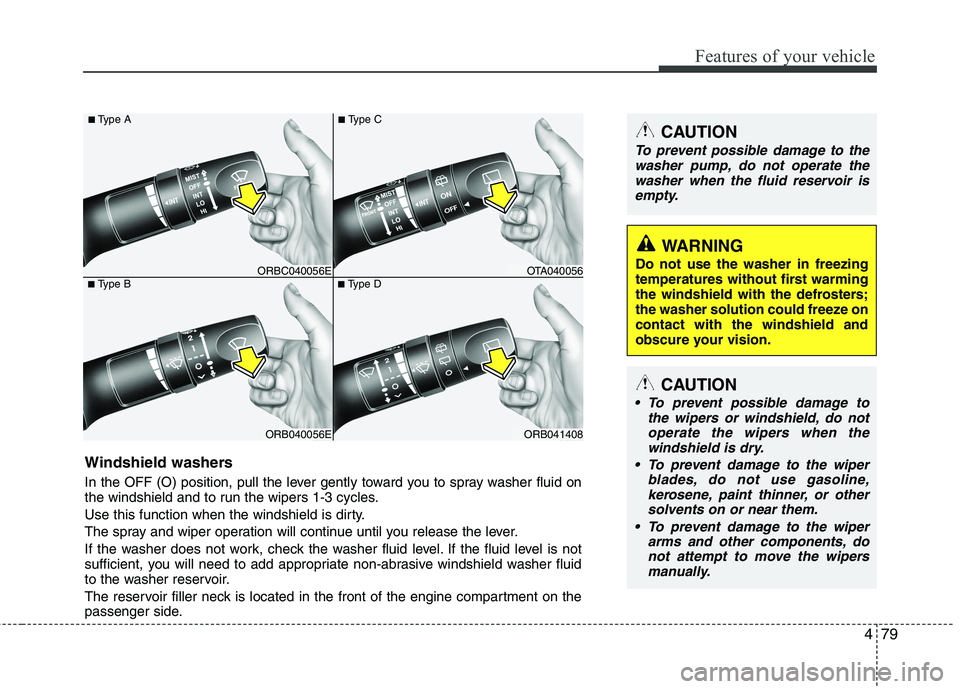
479
Features of your vehicle
ORB040056E
■
Type B
ORBC040056E
■
Type A
ORB041408
■
Type D
OTA040056
■
Type C
Windshield washers
In the OFF (O) position, pull the lever gently toward you to spray washer fluid on
the windshield and to run the wipers 1-3 cycles.
Use this function when the windshield is dirty.
The spray and wiper operation will continue until you release the lever.
If the washer does not work, check the washer fluid level. If the fluid level is not
sufficient, you will need to add appropriate non-abrasive windshield washer fluid
to the washer reservoir.
The reservoir filler neck is located in the front of the engine compartment on the
passenger side.
CAUTION
To prevent possible damage to the
washer pump, do not operate the
washer when the fluid reservoir is empty.
WARNING
Do not use the washer in freezing
temperatures without first warming
the windshield with the defrosters;
the washer solution could freeze oncontact with the windshield and
obscure your vision.
CAUTION
To prevent possible damage to the wipers or windshield, do not
operate the wipers when the windshield is dry.
To prevent damage to the wiper blades, do not use gasoline,
kerosene, paint thinner, or othersolvents on or near them.
To prevent damage to the wiper arms and other components, do
not attempt to move the wipersmanually.
Page 153 of 840
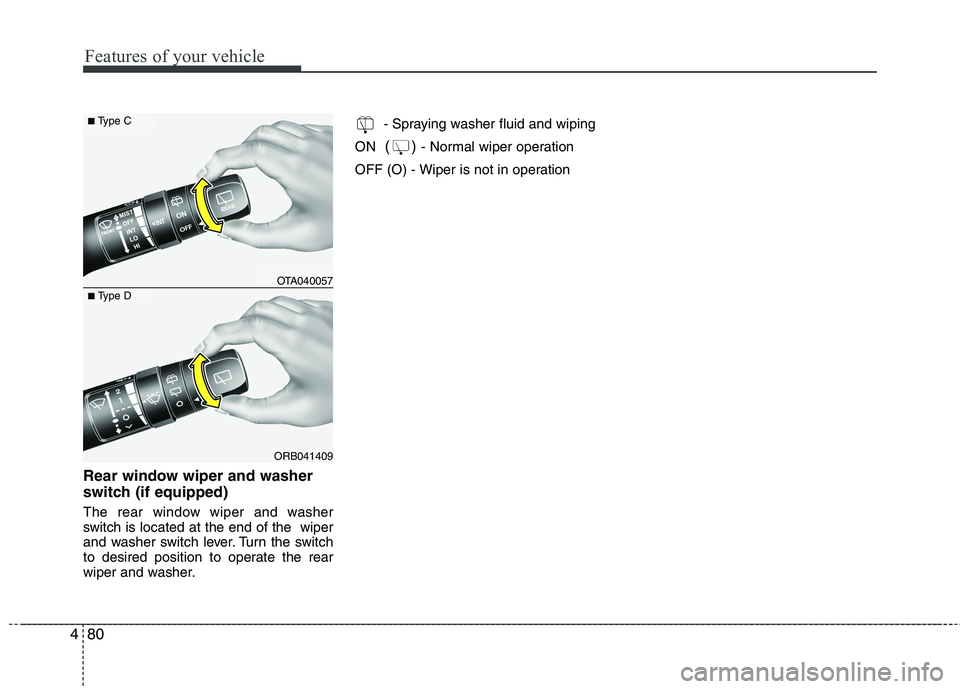
Features of your vehicle
80
4
Rear window wiper and washer
switch (if equipped)
The rear window wiper and washer
switch is located at the end of the wiper
and washer switch lever. Turn the switch
to desired position to operate the rear
wiper and washer. - Spraying washer fluid and wiping
ON ()
- Normal wiper operation
OFF (O) - Wiper is not in operation
ORB041409
■ Type C
■Type DOTA040057
Page 333 of 840
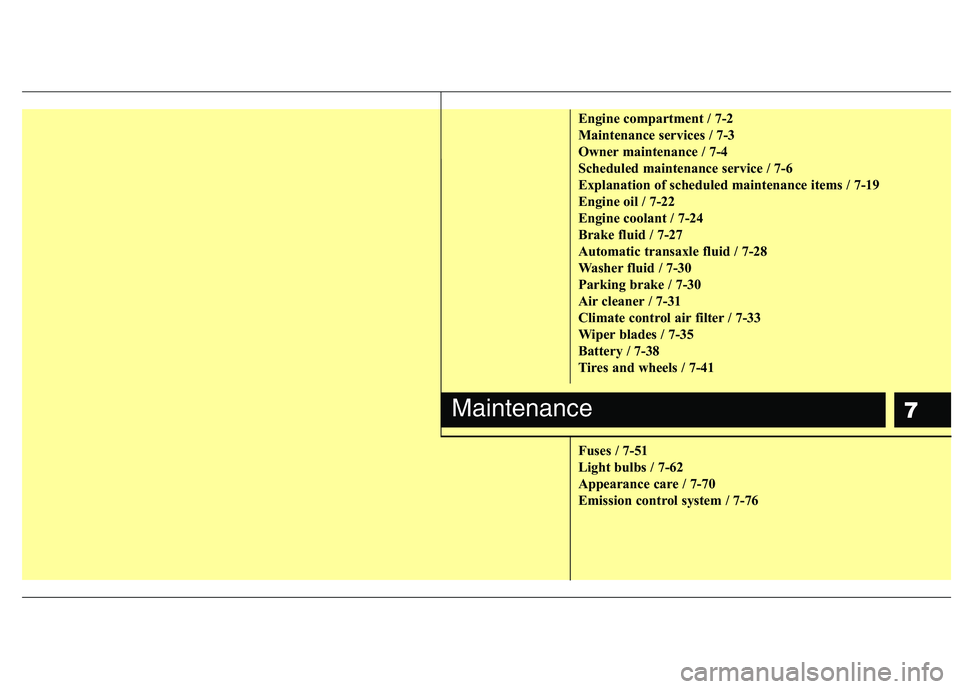
7
Engine compartment / 7-2
Maintenance services / 7-3
Owner maintenance / 7-4
Scheduled maintenance service / 7-6
Explanation of scheduled maintenance items / 7-19
Engine oil / 7-22
Engine coolant / 7-24
Brake fluid / 7-27
Automatic transaxle fluid / 7-28
Washer fluid / 7-30
Parking brake / 7-30
Air cleaner / 7-31
Climate control air filter / 7-33
Wiper blades / 7-35
Battery / 7-38
Tires and wheels / 7-41
Fuses / 7-51
Light bulbs / 7-62
Appearance care / 7-70
Emission control system / 7-76
Maintenance
Page 337 of 840
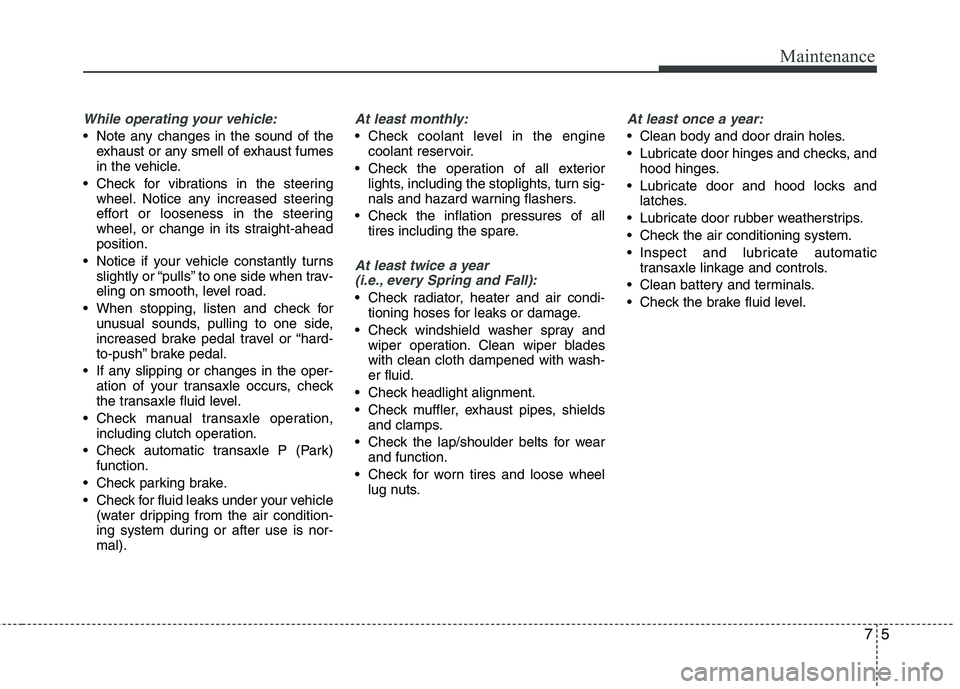
75
Maintenance
While operating your vehicle:
Note any changes in the sound of theexhaust or any smell of exhaust fumes
in the vehicle.
Check for vibrations in the steering wheel. Notice any increased steering
effort or looseness in the steering
wheel, or change in its straight-aheadposition.
Notice if your vehicle constantly turns slightly or “pulls” to one side when trav-
eling on smooth, level road.
When stopping, listen and check for unusual sounds, pulling to one side,
increased brake pedal travel or “hard-
to-push” brake pedal.
If any slipping or changes in the oper- ation of your transaxle occurs, check
the transaxle fluid level.
Check manual transaxle operation, including clutch operation.
Check automatic transaxle P (Park) function.
Check parking brake.
Check for fluid leaks under your vehicle (water dripping from the air condition-
ing system during or after use is nor-mal).
At least monthly:
Check coolant level in the enginecoolant reservoir.
Check the operation of all exterior lights, including the stoplights, turn sig-
nals and hazard warning flashers.
Check the inflation pressures of all tires including the spare.
At least twice a year
(i.e., every Spring and Fall):
Check radiator, heater and air condi- tioning hoses for leaks or damage.
Check windshield washer spray and wiper operation. Clean wiper blades
with clean cloth dampened with wash-er fluid.
Check headlight alignment.
Check muffler, exhaust pipes, shields and clamps.
Check the lap/shoulder belts for wear and function.
Check for worn tires and loose wheel lug nuts.
At least once a year:
Clean body and door drain holes.
Lubricate door hinges and checks, andhood hinges.
Lubricate door and hood locks and latches.
Lubricate door rubber weatherstrips.
Check the air conditioning system.
Inspect and lubricate automatic transaxle linkage and controls.
Clean battery and terminals.
Check the brake fluid level.
Page 426 of 840

I9
Index
Vanity mirror lamp........................................................4-106
Vehicle break-in process ..................................................1-4
Vehicle certification label ................................................8-6
Vehicle identification number (VIN) ................................8-6
Vehicle stability management (VSM) ............................5-42
Vehicle weight ................................................................5-63
Base curb weight ......................................................5-63
Cargo weight ............................................................5-63
GAW (Gross axle weight) ........................................5-63
GAWR (Gross axle weight rating) ............................5-63
GVW (Gross vehicle weight)....................................5-63
GVWR (Gross vehicle weight rating) ......................5-63
Washer fluid ....................................................................7-30
Waste tray, see ashtray ..................................................4-104
Warnings and indicators..................................................4-56
Weight ............................................................................5-63 Base curb weight ......................................................5-63
Cargo weight ............................................................5-63
GAW (Gross axle weight) ........................................5-63
GAWR (Gross axle weight rating) ............................5-63
GVW (Gross vehicle weight)....................................5-63
GVWR (Gross vehicle weight rating) ......................5-63 Wheel alignment and tire balance ..................................7-44
Wheel replacement ........................................................7-46
Windows ........................................................................4-21
Auto down window ..................................................4-22
Auto up/down window ..............................................4-23
Power window lock button........................................4-24
Windshield defrosting and defogging ..........................4-100 Defogging logic ......................................................4-102
Winter driving ................................................................5-51 Snow tires ..................................................................5-51
Tire chains ................................................................5-52
Wiper blades ..................................................................7-35
Wipers and washers ........................................................4-77
V
W
Page 575 of 840

Features of your vehicle
76
4
Windscreen washers
In the OFF (O) position, pull the lever
gently toward you to spray washer fluid
on the windscreen and to run the wipers
1-3 cycles. Use this function when the windscreen is
dirty.
The spray and wiper operation will con-
tinue until you release the lever.
If the washer does not work, check the
washer fluid level. If the fluid level is not
sufficient, you will need to add appropri-
ate non-abrasive windscreen washer
fluid to the washer reservoir.
The reservoir filler neck is located in the
front of the engine compartment on the
driver side.
■ Type B
■
Type A■Type E
■Type C
ORBC040056E/ORB040056E/ORBI041056/OTA040056/ORB041408/OTA040056R ■
Type F
■
Type D
CAUTION
To prevent possible damage to the
washer pump, do not operate the
washer when the fluid reservoir is empty.
Page 576 of 840
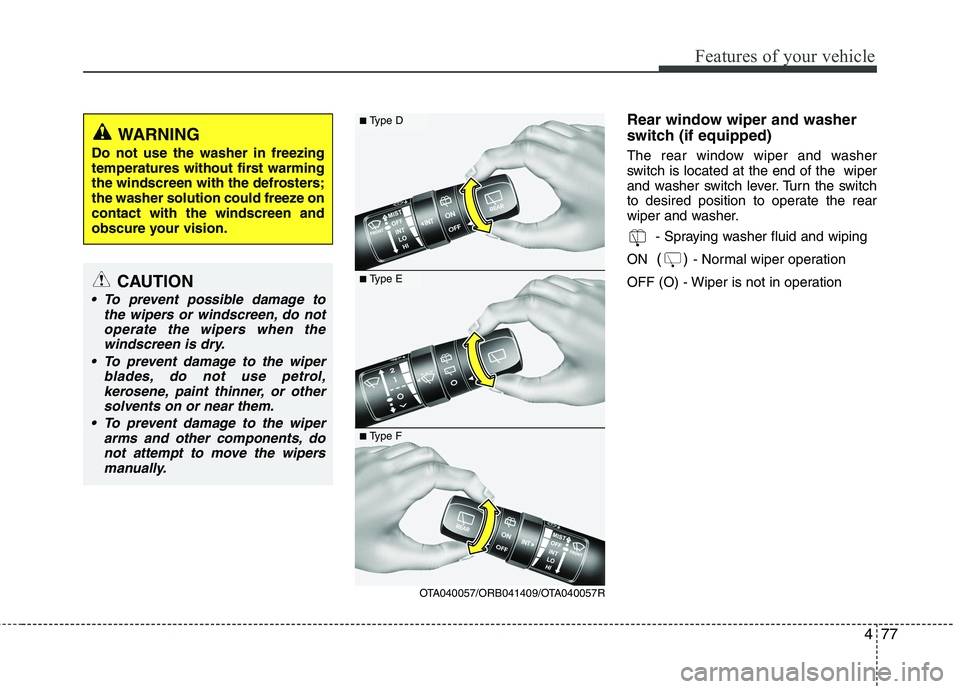
477
Features of your vehicle
Rear window wiper and washer
switch (if equipped)
The rear window wiper and washer
switch is located at the end of the wiper
and washer switch lever. Turn the switch
to desired position to operate the rear
wiper and washer.- Spraying washer fluid and wiping
ON () - Normal wiper operation
OFF (O) - Wiper is not in operation■ Type D
■Type E
OTA040057/ORB041409/OTA040057R
■
Type F
WARNING
Do not use the washer in freezing
temperatures without first warming
the windscreen with the defrosters;
the washer solution could freeze oncontact with the windscreen and
obscure your vision.
CAUTION
To prevent possible damage to the wipers or windscreen, do not
operate the wipers when thewindscreen is dry.
To prevent damage to the wiper blades, do not use petrol,kerosene, paint thinner, or other
solvents on or near them.
To prevent damage to the wiper arms and other components, donot attempt to move the wipers
manually.
Page 748 of 840

7
Engine compartment / 7-2
Maintenance services / 7-3
Owner maintenance / 7-4
Scheduled maintenance service / 7-6
Explanation of scheduled maintenance items / 7-18
Engine oil / 7-21
Engine coolant / 7-23
Brake fluid / 7-26
Automatic transaxle fluid / 7-27
Washer fluid / 7-29
Parking brake / 7-29
Air cleaner / 7-30
Climate control air filter / 7-32
Wiper blades / 7-34
Battery / 7-37
Tyres and wheels / 7-40
Fuses / 7-50
Light bulbs / 7-61
Appearance care / 7-69
Emission control system / 7-75
Maintenance
Page 752 of 840
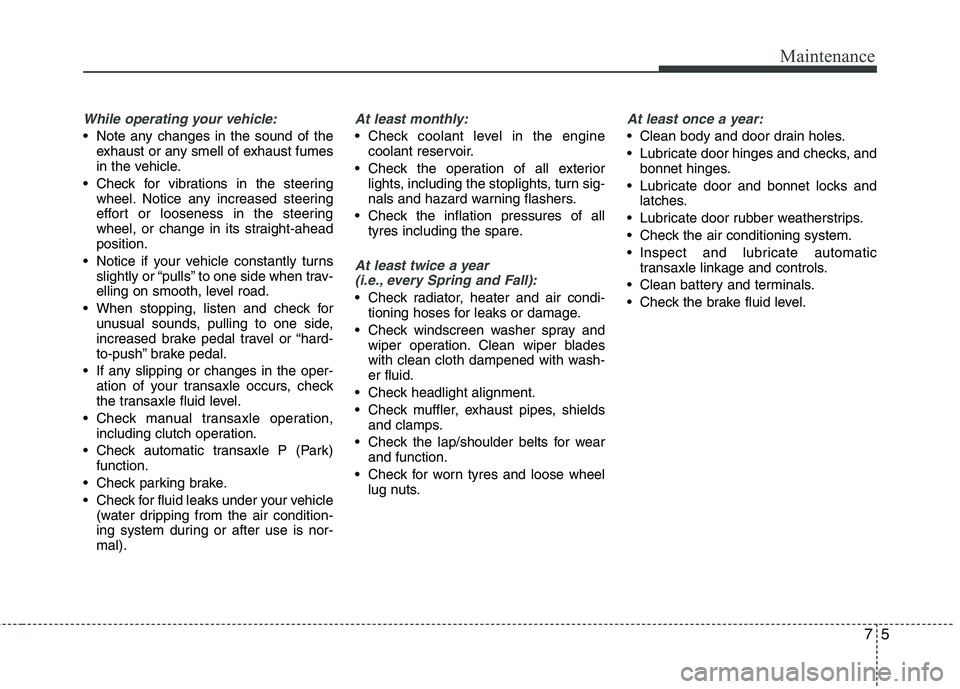
75
Maintenance
While operating your vehicle:
Note any changes in the sound of theexhaust or any smell of exhaust fumes
in the vehicle.
Check for vibrations in the steering wheel. Notice any increased steering
effort or looseness in the steering
wheel, or change in its straight-aheadposition.
Notice if your vehicle constantly turns slightly or “pulls” to one side when trav-
elling on smooth, level road.
When stopping, listen and check for unusual sounds, pulling to one side,
increased brake pedal travel or “hard-
to-push” brake pedal.
If any slipping or changes in the oper- ation of your transaxle occurs, check
the transaxle fluid level.
Check manual transaxle operation, including clutch operation.
Check automatic transaxle P (Park) function.
Check parking brake.
Check for fluid leaks under your vehicle (water dripping from the air condition-
ing system during or after use is nor-mal).
At least monthly:
Check coolant level in the enginecoolant reservoir.
Check the operation of all exterior lights, including the stoplights, turn sig-
nals and hazard warning flashers.
Check the inflation pressures of all tyres including the spare.
At least twice a year
(i.e., every Spring and Fall):
Check radiator, heater and air condi- tioning hoses for leaks or damage.
Check windscreen washer spray and wiper operation. Clean wiper blades
with clean cloth dampened with wash-er fluid.
Check headlight alignment.
Check muffler, exhaust pipes, shields and clamps.
Check the lap/shoulder belts for wear and function.
Check for worn tyres and loose wheel lug nuts.
At least once a year:
Clean body and door drain holes.
Lubricate door hinges and checks, andbonnet hinges.
Lubricate door and bonnet locks and latches.
Lubricate door rubber weatherstrips.
Check the air conditioning system.
Inspect and lubricate automatic transaxle linkage and controls.
Clean battery and terminals.
Check the brake fluid level.
Page 840 of 840
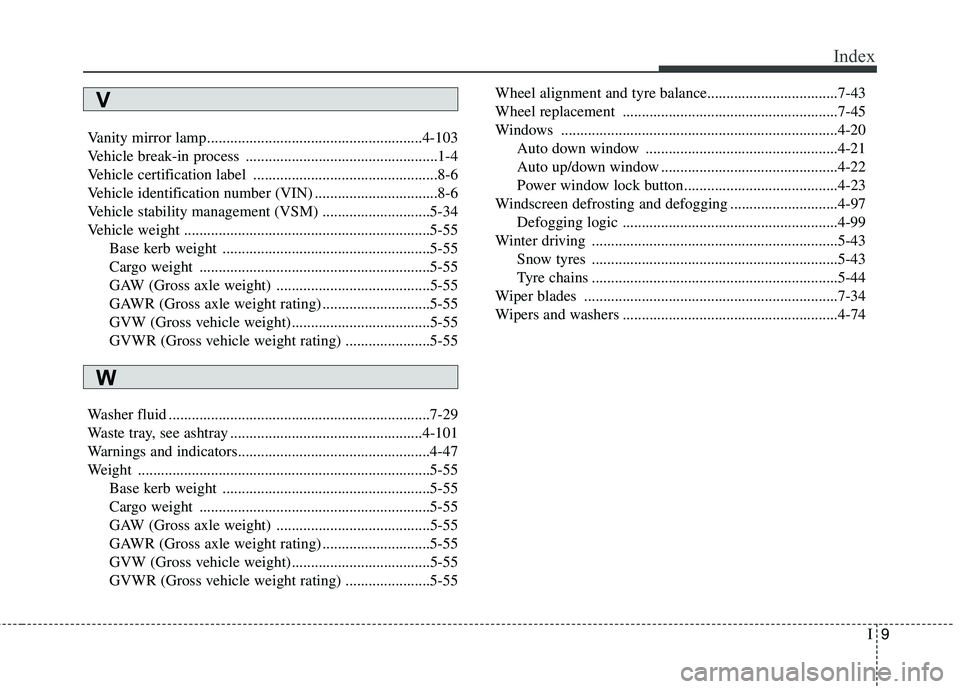
I9
Index
Vanity mirror lamp........................................................4-103
Vehicle break-in process ..................................................1-4
Vehicle certification label ................................................8-6
Vehicle identification number (VIN) ................................8-6
Vehicle stability management (VSM) ............................5-34
Vehicle weight ................................................................5-55
Base kerb weight ......................................................5-55
Cargo weight ............................................................5-55
GAW (Gross axle weight) ........................................5-55
GAWR (Gross axle weight rating) ............................5-55
GVW (Gross vehicle weight)....................................5-55
GVWR (Gross vehicle weight rating) ......................5-55
Washer fluid ....................................................................7-29
Waste tray, see ashtray ..................................................4-101
Warnings and indicators..................................................4-47
Weight ............................................................................5-55 Base kerb weight ......................................................5-55
Cargo weight ............................................................5-55
GAW (Gross axle weight) ........................................5-55
GAWR (Gross axle weight rating) ............................5-55
GVW (Gross vehicle weight)....................................5-55
GVWR (Gross vehicle weight rating) ......................5-55 Wheel alignment and tyre balance..................................7-43
Wheel replacement ........................................................7-45
Windows ........................................................................4-20
Auto down window ..................................................4-21
Auto up/down window ..............................................4-22
Power window lock button........................................4-23
Windscreen defrosting and defogging ............................4-97 Defogging logic ........................................................4-99
Winter driving ................................................................5-43 Snow tyres ................................................................5-43
Tyre chains ................................................................5-44
Wiper blades ..................................................................7-34
Wipers and washers ........................................................4-74
V
W